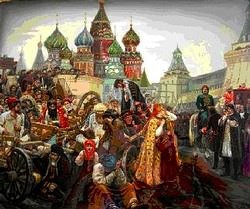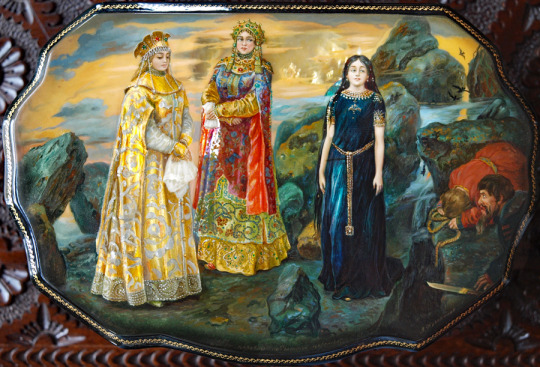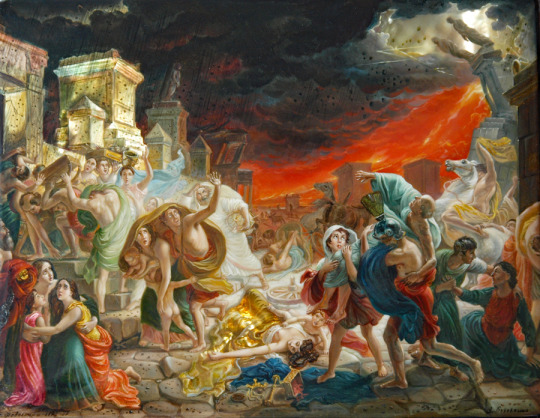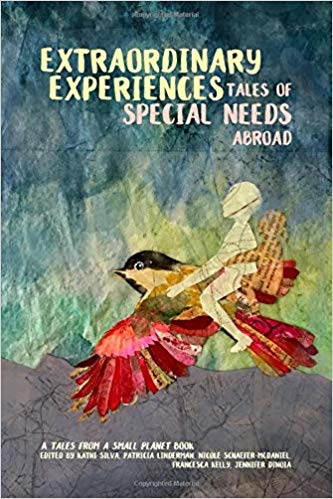The Lacquer Boxes of Fedoskino
May 2016
The Road Less Traveled
By Hayley Alexander
Most visitors to Russia - and even those who have never been there - are familiar with at least two traditional Russian handcrafted items. The first and most widely recognized are the stacking wooden matrushka dolls. The second are the lacquered papier-mâché boxes.

[”The Morning of the Streltsy Execution,” lacquer plaque detail with mother of pearl. Original oil by Vasily Surikov, Tretyakov Gallery Moscow]
Like all handmade items and souvenirs popular with tourists, there are the exceptionally good, the good, the not so good, and yes the ugly, each with commensurate price ranges. My wife Linda and I, new expatriates in Moscow, found that the matrushka dolls held little appeal for us, but the lacquer boxes did. While working at the U.S. Embassy, Linda became acquainted with a Russian woman, Anya, who knew many artists in Fedoskino, the first of four towns to produce the traditional lacquer boxes (others being Palekh, Mystera and Kholui). Fedoskino is just over an hour outside of Moscow, making a trip there by car a simple proposition and something we felt my visiting parents would enjoy. Linda contacted Anya to arrange a visit with some of the artists in their houses and studios.
On a Saturday morning, my parents, Linda and I, and Anya and her husband Robert, compacted ourselves into Robert’s aging black Volga bound for Fedoskino. Anya was a schoolteacher, originally from the Republic of Georgia. Robert was a retired Russian Air Force fighter pilot who had lived the privileged life of a decorated military officer, a distinction held in the highest social esteem until the Soviet Union ceased to be. Anya and Robert were complete opposites. He was introspective and taciturn, clearly struggling with the transformation his country was undergoing. Conversely Anya’s loquaciousness, somewhat typical of people from the Republic of Georgia, more than made up for Robert’s apparent shyness. While Anya’s English was quite good Robert’s was non-existent, leaving Anya to take on the dual roles of tour guide and interpreter.
Like most of Russia’s citizens, Robert, Anya and their two sons were having difficulty making ends meet. He was entitled to a military pension and she to a teacher’s salary, yet neither received their salaries more than a couple of times per year and usually six months in arrears. Out of necessity, Anya began supplementing her family’s paltry income as a kind of sales agent for several Fedoskino artists, selling their work largely to foreigners through various embassies.
The decrepit black Volga rattled and creaked its way down poorly maintained asphalt roads, becoming gradually worse the farther outside of Moscow we got. My mother and stepfather (Don) were curious about Robert and Anya’s lives and chatted with them most of the way. Anya frequently alluded to a difficult existence in comparison with perhaps overly fond recollections of Soviet times. Even so, neither claimed to have any desire to return to those days, mainly because they surmised the bitter pill now being swallowed would eventually result in a better living standard. As Anya continued, I noticed the road narrowing, becoming encroached upon by bushes scraping the right side of the car. She stopped mid-sentence to announce we had entered Fedoskino.
It appeared the village didn’t have a center, merely a amalgamation of roads snaking out from a disordered grouping of buildings. Most of the houses were of log construction, built centuries ago, and located next to single-lane dirt tracks used for oxcarts. Whereas they now found their front doors abutting paved roads carrying automobiles. The typical Fedoskino dwelling was a diminutive, unpainted wooden structure with one main room, a small kitchen and one or two tiny bedrooms. The better ones featured an indoor bathroom, although many still lacked this twentieth-century convenience. Most were surrounded by subsistence vegetable plots providing much of the inhabitants’ food. Scattered here and there, corrupting the otherwise bucolic scene, were Soviet apartment blocks of decaying concrete.
The only aspect of Fedoskino that differentiated it from multitudes of other villages in the vastness of Russia was its economic reliance on lacquer box production. The sole visible evidence of this, as Anya pointed out, was a run-down training institute for aspiring artists sitting amid a stand of trees somewhere near the imaginary center of town. Otherwise there were no pretenses concerning the town’s supposed pre-eminence in Russian folk art. No signs to greet visitors: “Home of the World-Famous Lacquer Boxes” or “AAA League Lacquer Box National Champions…”
Despite the village’s unassuming appearance, one notable standout was a house belonging to the first artist couple we visited, both obviously commercially successful. We met them in a typical little shack; however, in an adjacent lot a new manse was under construction dwarfing any other house in the area. Large even by American standards, this was a two-story, four-bedroom structure replete with all amenities. The couple invited us to sit, drink tea and view some of their work. Their existing hovel was cramped, with low ceilings and creaky wooden floors. We were offered a seat on a long couch and two overstuffed chairs, all covered in brightly colored blankets, then handed a selection of lacquer boxes and plaques to examine.
The Fedoskino painting technique is immediately distinguishable from the other Russian lacquer box styles in two ways. First, the others are categorically folk art, whereas Fedoskino paintings are inspired by classical and realist styles. Second, the Fedoskino artists typically use either inlaid mother of pearl or applied gold leaf to illuminate scenes or portraits through semi-transparent paint. When properly done, the effect is stunning. As we looked at the remarkable detail of their work, we exchanged views on the normalized relations between our two countries and the pointless excesses of the cold war. They were as relieved as we were that the political mess separating us for so many years was now a fading memory. After an hour or so admiring their work - not ready to buy just yet - we parted and watched them wave goodbye from the door of their log house with the surreal mansion-to-be looming behind.

We repeated this process several times, visiting an elderly artist who was a professor at the institute; a young man gaining a reputation as a rising talent; the rising talent’s mother, also an artist though perhaps less of a talent; a man thought to be the best in creating wooded landscapes; another who painted icons for churches; and a woman who specialized in miniature portraits, mainly of women. Late afternoon was approaching and the village basked in a warm amber glow. The slow pace of life meandered on in Fedoskino largely indifferent to the presence of foreigners. Between the four of us we had only purchased a few trinkets, none of them capturing the essence of the better Fedoskino work we had seen with vendors back in Moscow.
Anya had planned our visits carefully. All of the artists we visited were proficient in their craft, even if some of their individual styles didn’t particularly appeal to us. Clearly, though, she had saved the best for last. There was only one artist remaining for the day; her name was Zena. My brain conjured images of a warrior princess. Again we all squeezed into Robert’s Volga, this time onward to Zena’s place in one of the dreary concrete apartment blocks.
Zena greeted us with the same hospitality we were now becoming accustomed to and invited us to sit around her pine kitchen table. She began to boil water for our sixth cup of strong black tea that afternoon, offering up a plate of Red October chocolates in the process. Her place was nicer than could have been imagined from the exterior. A quick look around revealed several sizable, nicely furnished rooms with higher ceilings than we had seen in most other places that day. She had clearly achieved the upper echelon in terms of commercial success. Zena brought out a selection of her work while Anya initiated a carefully orchestrated series of barely discernable winks, nods and gestures to coach Zena’s actions. Anya had been observing our tastes for much of the day, information now useful to ascertain what we might be prone to purchase. Zena’s work was nothing short of remarkable in its detail, use of color, luminosity and ability to create facial likenesses. We were awestruck by her talent and how her work stood out from everyone else’s. It was unanimous; Zena was the one from whom we’d each commission work. She then provided some Russian art books to give us ideas.
As we sat there I was acutely struck by what Linda and I had embarked upon in our new life together. I looked around, as if a detached observer, and realized how much our lives had changed in such a short span of time. Here I was with my new wife and my parents, sitting in an artist’s apartment, in a small Russian village, somewhere south of Moscow, on a tepid summer evening paging through books of classical paintings by brilliant artists I had never even heard of only months before.

It was an invigorating and dreamlike sensation. A window was open behind me. The fragrant air of the rural village filled the room and mixed with the scent of the tea wafting up from a kettle on the stove. A dog barked off in the distance and a couple of birds rustled branches immediately outside the window. The entire day had been worth this moment, just to now be sitting around the table in this remarkable Russian artist’s kitchen. Zena was a pleasant woman: tall, not particularly thin, with reddish wavy hair and a slightly shy, self-effacing smile. As I looked at her I recalled some of the so-called crafts I’d seen in America: painted clowns, children with beaming faces, little pigs, frogs, and other kitschy stuff. Then I looked at what was before us and how remarkably talented though unpresumptuous this woman was. Zena explained in subdued, affable tones how she most appreciated projects that challenged her skills, those in which intricate detail was required. She was particularly renowned for her faces, and any opportunity to paint them pleased her.
One of the art books being passed around the table was, coincidentally, The Works of the Tretyakov Gallery. We had just visited this extraordinary collection of 19th and 20th century Russian art a few days before, and we perused the book to find the paintings we had most admired. To make the selection process a little more fluid, Anya motioned Zena to offer us a libation. Russian champagne and Ukrainian brandy appeared, and the desired effect was quickly achieved. Amid a euphoric haze and increasingly lively discussion, My mother, Don, Linda and I each commissioned selections from the Tretyakov book. Zena then painstakingly discussed her vision for each piece and sought our concurrence. Only happy to oblige her love of intricate and challenging projects, I selected a classical work depicting The Last Day of Pompeii with over 30 faces, each distinct and imbued with emotion.
We picked up the finished items two months later. Zena handed me mine with outstretched palms, looked me straight in the eyes, smiled and said: “Never again will I undertake such a project.” I suppose I took her desire to paint faces a touch too literally. We sat with her for a while again in her kitchen, talked like old friends and watched her unveil the completed works. They were, without exception, exquisite and exceeded our expectations.
We made several trips back to Fedoskino over the next two years to see Zena and order more boxes and plaques, occasionally with new visitors equally enthralled by her talents. Some day we hope to return to the sleepy village, drink tea and reminisce around her kitchen table once again.
© 2005 by Hayley Alexander. All rights reserved.
_
Hayley Alexander is an American consultant in economic development. After receiving an MBA from George Washington University, he worked for ten years in an automotive-related manufacturing company in the Detroit area. Needing a change from American suburbia, he accepted a position with the consulting arm of a large US-based firm undertaking World Bank and USAID overseas development programs. This began an expatriate odyssey which took him and his wife to seven Eastern European and African countries for assignments ranging from 1 to 3 ½ years each. He continues his consulting work on short-term assignments in North Africa, the Middle East and Asia.
Hayley has recently published a book: “Pitting the Olives Might Help” illustrates the social and economic upheaval befalling Russia in the wake of the 1991 collapse of the Soviet apparatus. From the out-of-control Moscow street scene to a fledgling entrepreneurial spirit taking shape, post-Soviet Russia is revealed through the eyes of a neophyte expatriate. Find it on Amazon here: Pitting the Olives Might Help: A 1990s expatriate odyssey through unhinged Russia




